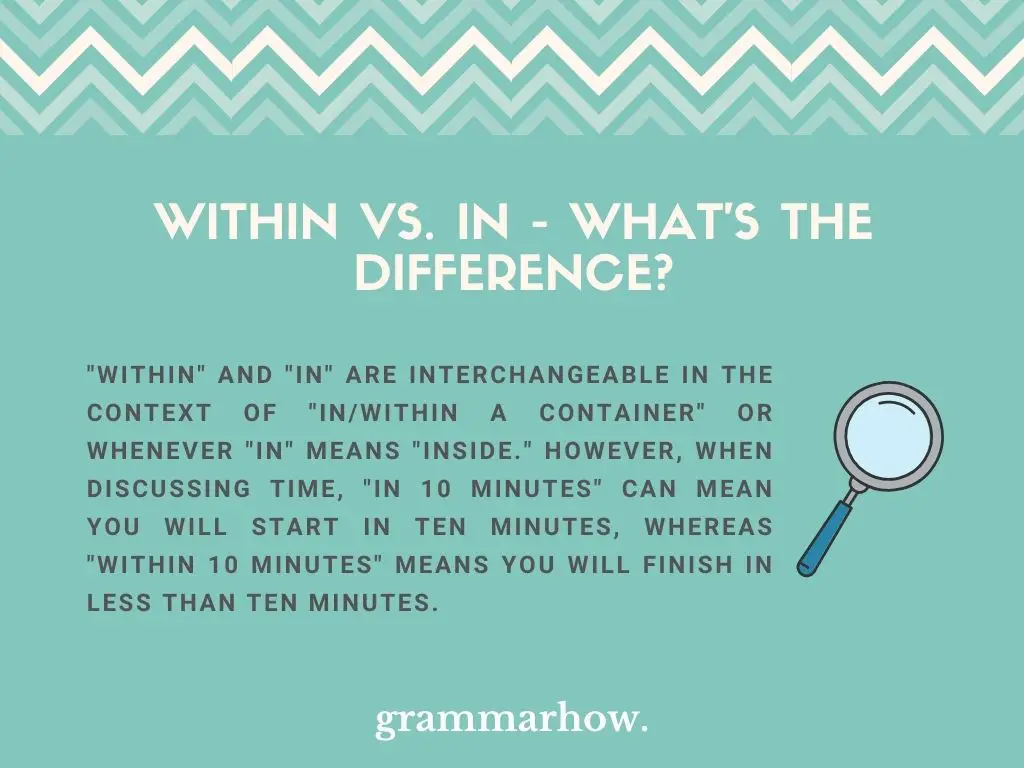Have you ever wondered what the difference is between “within” and “in”?
Once you have read this page, you will know what “in” and “within” mean and how and when to use them.
Within vs. In – What’s the Difference?
“Within” and “in” are interchangeable in the context of “in/within a container” or whenever “in” means “inside.” However, when discussing time, “in 10 minutes” can mean you will start in ten minutes, whereas “within 10 minutes” means you will finish in less than ten minutes.

The Cambridge Dictionary states that “within” means “inside or not further than an area or time” or “inside the limits of something.”
Whenever you can use the word “within,” you can “mostly” use the words “inside” or “in” with no change in meaning.
- He will arrive within/ inside an hour.
- He placed the coins within/in/inside the container.
However, the word “in” has far more uses than “within,” and in the first example above, the word “in” can also mean
- He will arrive in an hour’s time. (In 60 minutes)
There are also many occasions when you use “in” but cannot use “within” as a synonym.
- He has been getting in trouble at school.
- She is coming in to see us next week.
You have seen examples of how “in” and “within” differ. Keep scrolling to learn more about when you cannot use “within” to replace “in.”
Within
As the Cambridge Dictionary states, “within” means to be “inside” of something. “Within” is a close synonym of “in” and “inside.”
Therefore, whenever you can use “within,” you can usually use “in” or “inside.”
The time when you most commonly use “within” is to talk about things being “inside” containers, groups, or boundaries.
- His shot was not within the boundaries of the pitch.
- She was his main rival within the legal world.
- We need to stay within budget on this trip.
“Within” can also refer to people “within” a group:
- Within my family, there are no arguments.
- She promotes happiness within our group of friends.
In
The word “in” is a preposition with many uses, some of which are the same as “within.”
When referring to being “inside something,” the words “in” and “within” are the same.
For example:
- She placed all the sandwiches in/within the basket before we left.
- In/Within my family, there are a lot of conflicts.
However, there are many occasions when “in” and “within” differ in meaning. For example, when referring to time, the words are different:
- We will finish in two weeks. (It will take us two whole weeks)
- We will finish within two weeks. (It may take less than two weeks)
When talking about places “in” and “within” vary:
- She used to live in New York.
- She used to live within New York. INCORRECT
- She used to live within the city boundaries of New York. CORRECT
Also, when you refer to the body, “in” and “within” differ.
- What is in your hands?
- You have something in your eye.
Conclusion
“In” and “within” are the same when you use them to refer to something “inside” something. E.g., “She lived within/in the US for 20 years.”
However, the word “in” and “within” differ in meaning when referring to many things like time, places, and bodies. E.g., “I am in hospital” CANNOT be “I am within hospital.”
“In” has so many different uses that it is difficult to nail them all down. However, you should only use the word “within” to mean “inside” something.
